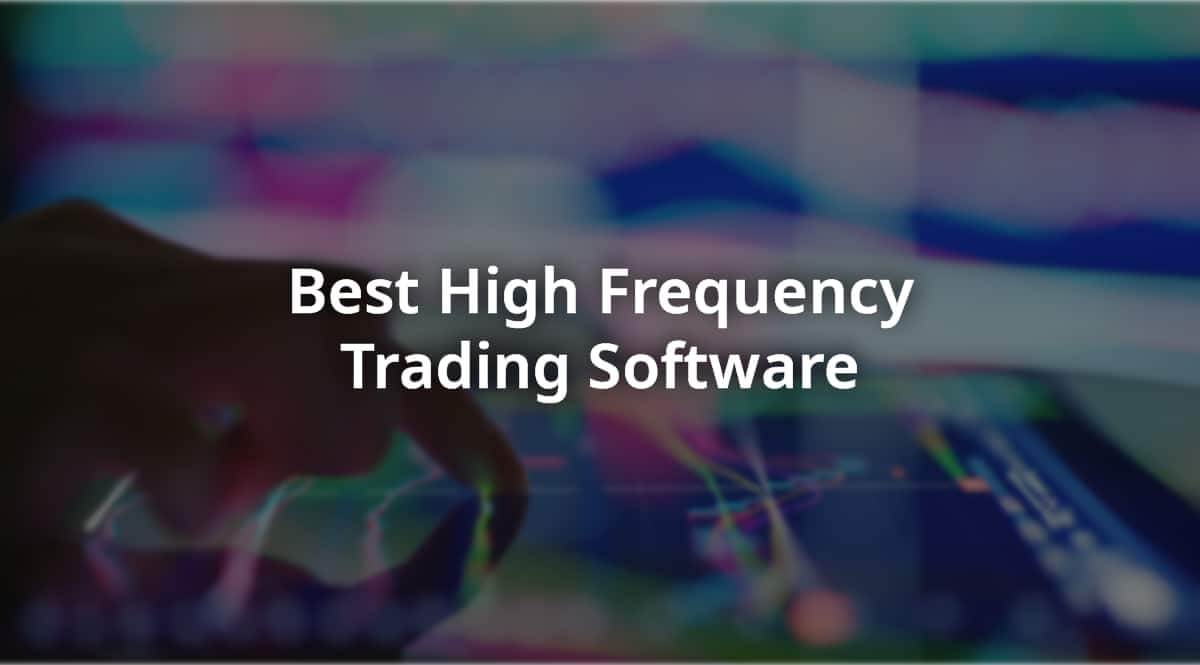
Best High-Frequency Trading Software You Need to Know
Selecting high-frequency trading software is a critical decision for any individual or institutional trader looking to engage in high-frequency trading.
HFT is a specialized form of trading that requires sophisticated technology and software to execute trades at incredibly high speeds.
Hence, selecting the best high-frequency trading software takes a lot of time and effort, as people can select from various high-frequency trading platforms.
Don’t worry! We are here to help you.
In this comprehensive guide, we’ll explore the key factors to consider when selecting HFT software, as well as the various options available in the market.
How to Select a High-Frequency Trading Platform (Detailed Instructions)
1. Latency and speed:
- Low-latency trading: In HFT, every millisecond counts. Look for ultra-low latency software to ensure that your orders are executed as quickly as possible. This includes both the software itself and the connectivity to the trading exchanges.
- Co-location services: Some HFT software providers offer co-location services, where your trading servers are physically located in close proximity to the exchange’s servers, reducing latency further.
2. Order execution:
- Smart order routing: HFT software should have intelligent order routing capabilities to find the best available prices across multiple exchanges.
- Algorithmic strategies: The software should support various algorithmic trading strategies, allowing you to customize and implement your preferred trading algorithms.

3. Data feed integration:
- Real-time data: Ensure that the software can seamlessly integrate with real-time market data feeds, as the accuracy and timeliness of data are crucial for HFT strategies.
- Historical data: Access to historical data is essential for backtesting and refining your trading strategies.
4. Risk management:
- Pre-trade risk controls: Look for software that offers robust pre-trade risk controls to prevent excessive losses due to erroneous trades or market volatility.
- Position monitoring: The software should provide real-time position monitoring and risk assessment tools to manage exposure effectively.
5. Scalability and capacity:
- Scalability: As your trading volume grows, your software should be able to handle increased trading activity without compromising performance.
- Redundancy: Consider whether the software offers redundancy and failover mechanisms to ensure continuous operation in case of system failures.
High-Frequency Trading Software and Custom Trading Algorithms

As stated earlier, it is quite hard to pick a high-frequency trading software due to various reasons. You need to be careful when it comes to high-frequency trading platforms.
6. Connectivity:
- Exchange connectivity: Ensure that the software supports connectivity to the exchanges you plan to trade on. Different exchanges may have varying technical requirements.
- Broker integration: If you’re using a broker, the software should be compatible with their trading infrastructure.
7. Customization and flexibility:
- Customizable algorithms: The ability to create and modify custom trading algorithms is essential for tailoring your strategies to changing market conditions.
- API support: Look for software that offers comprehensive APIs (Application Programming Interfaces) for customization and integration with other trading tools.
8. Backtesting and simulation:
- Historical simulation: The software should allow you to backtest your strategies using historical data to assess their performance before deploying them in live markets.
- Realistic slippage models: Ensure that the backtesting tool incorporates realistic slippage models to account for the impact of trading at high speeds.
9. Support and Maintenance:
- Technical support: Consider the level of technical support and maintenance provided by the software provider. HFT systems require quick responses to technical issues.
- Software updates: Regular software updates and patches are crucial to address security vulnerabilities and improve performance.
10. Compliance and Regulatory Considerations:
- Compliance features: Ensure the software includes features to help you comply with relevant regulations.
- Risk mitigation: Verify that the software aligns with regulatory requirements for risk management and trade surveillance.
11. Cost and Pricing Models:
- Upfront costs: Consider the initial setup costs, including software licensing fees and hardware requirements.
- Transaction costs: Understand the transaction costs associated with using the software, including data feed subscriptions and exchange fees.
- Total cost of ownership (TCO): Evaluate the TCO over time, factoring in ongoing maintenance, support, and infrastructure costs.
High-Frequency Trading Risks

We can’t forget about risk factors when it comes to HFT firms.
12. Security:
- Data security: Ensure that the software has robust security measures in place to protect sensitive trading data.
- Access controls: Implement strong access controls and authentication mechanisms to prevent unauthorized access to your trading infrastructure.
13. Reputation and track record:
- Vendor reputation: Research the reputation and track record of the software provider. Consider user reviews and testimonials.
- Case studies: Look for case studies or success stories involving the software to gauge its effectiveness.
14. User Interface and Monitoring Tools:
- User-friendly interface: A user-friendly interface can make monitoring and managing your trading operations easier.
- Real-time monitoring: The software should provide real-time monitoring tools to track your trading strategies and performance.
15. Regulatory and exchange compliance:
- Compliance with regulations: Ensure the software complies with the specific regulatory requirements of the regions or exchanges you plan to trade on.
- Certifications: Some software providers may have certifications or partnerships with exchanges that can streamline your compliance efforts.

16. Performance analytics:
- Performance metrics: Look for software that provides detailed performance analytics, including metrics like execution speed, fill rates, and P&L analysis.
17. Disaster recovery and contingency planning:
- Disaster recovery: Evaluate the software’s disaster recovery and contingency planning capabilities to ensure business continuity in case of unexpected events.
18. Market access and asset coverage:
- Market access: Confirm that the software supports the asset classes and markets you intend to trade in.
- Global reach: If you trade internationally, assess the software’s ability to access global markets.
19. Vendor lock-in:
- Avoid vendor lock-in: Consider whether the software ties you to a specific vendor or infrastructure. Vendor lock-in can limit your flexibility.
20. User training and documentation:
- Training resources: Check if the software provider offers training resources and documentation to help users make the most of the platform.
Best HFT firms: Interactive Brokers
Interactive Brokers is a well-established, highly reputable multi-asset broker renowned for its extensive range of global markets available for trading.
It is known for its competitive fee structure and provides traders with access to high-quality research and educational resources. Additionally, Interactive Brokers offers a modern, institutional-grade suite of trading platforms.
One of the standout features of Interactive Brokers is its strong appeal to professional traders.
Interactive Brokers has a long and reputable history. Furthermore, it is publicly listed on NASDAQ under the ticker symbol IBKR and is regulated in an impressive nine Tier-1 jurisdictions. This extensive regulatory oversight provides traders with a high level of confidence and trust in the broker’s operations.
Interactive Brokers and Its Users

Financially, Interactive Brokers is robust, with Ending Client Equity totalling USD 373.8 billion and Equity Capital amounting to USD 10.01 billion. Therefore, this financial stability is a testament to the broker’s reliability and ability to safeguard client funds.
Interactive Brokers offers access to a diverse array of global financial markets, spanning from stocks and options to futures and spot forex.
Traders can tap into 135 market centres across 33 countries and transact in 23 different currencies. However, it’s important to mention that retail spot forex trading isn’t available to U.S. residents, and for U.S. forex trading, traders should refer to Interactive Brokers’ U.S. forex brokers guide.
We also need to mention that these advanced features may be overwhelming for beginners. Furthermore, Interactive Brokers doesn’t offer MetaTrader as an alternative platform option.
The broker’s web-based Client Portal has undergone significant improvements, making it user-friendly for forex trading. It includes integrated news headlines and an economic calendar, enhancing the trading experience by providing valuable information and insights.
Furthermore, for traders seeking a desktop trading platform, Interactive Brokers offers Trader Workstation (TWS), which is a feature-rich platform. TWS caters to the needs of seasoned traders and professionals, offering a wide array of advanced trading tools.
While Interactive Brokers excels in serving professional traders, it may not be the ideal choice for inexperienced traders due to the complexity of its Trader Workstation (TWS) desktop platform. Additionally, MetaTrader, a popular trading platform among beginners and experienced traders alike, is not available as an alternative platform option at Interactive Brokers.
Conclusion
Selecting the right HFT software is a critical decision that requires careful consideration of factors such as speed, reliability, scalability, customization, compliance, and cost. It’s advisable to thoroughly research and test different options, possibly through trial periods or simulations, before committing to a particular HFT software solution.
Keep in mind that the HFT landscape is continually evolving, so staying informed about the latest developments and technologies is essential to maintaining a competitive edge in the high-frequency trading arena.




